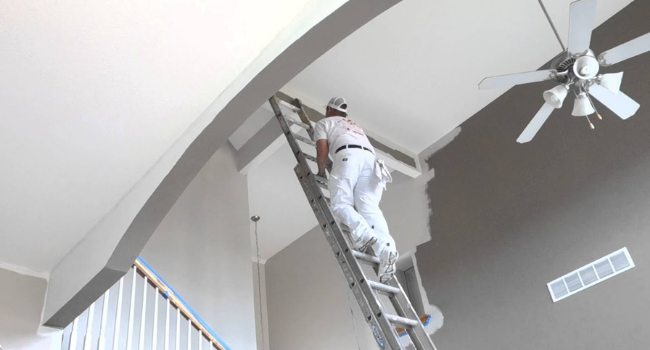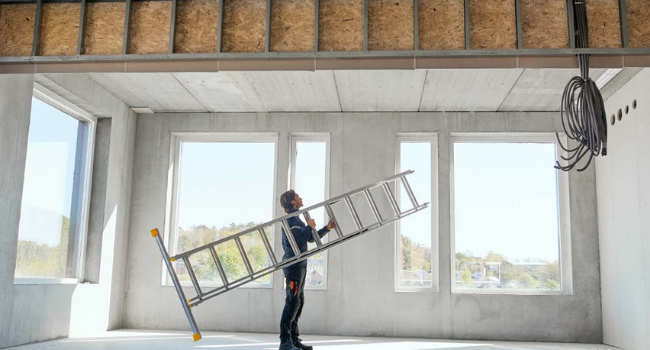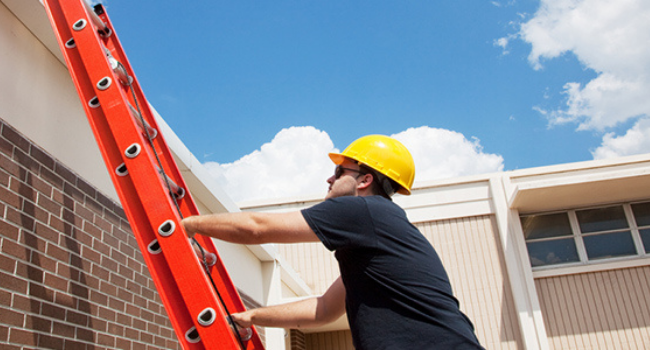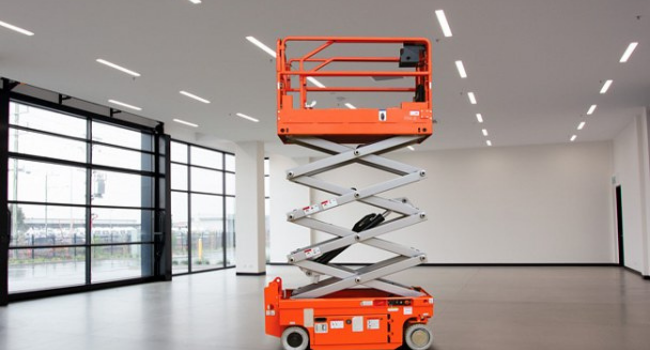The average ceiling height is 9 feet, but some homeowners prefer to go beyond that. High ceilings can be really charming, especially if you’re fond of flashy chandeliers.
However, reaching a 20-feet ceiling is way more difficult than you may think. Whether replacing a light bulb, removing cobwebs, or painting your ceiling, it’s impossible if you do not have the required tools to reach the highest parts in your house.
Certainly, that’s what ladders are for, and there are different types available. However, how would you reach a 20-foot ceiling that standard stepladders can’t reach?
Well, in that case, your best bet is an articulating ladder or extension ladder. But, what matters even more than the ladder types is your safety.
If you have been wondering how to reach your high ceiling for cleaning or painting, you have come to the right place. This article highlights how to reach a 20-foot ceiling and the safety tips while reaching high ceilings. Keep reading to find out more.
How To Reach 20 Foot Ceiling With Proper Safety Measures?
There could be a million reasons why you are seeking an answer. Probably you want to change your ceiling paint or simply install a ceiling fan or other decorative pieces; the list is endless.
Without proper tools, reaching high ceilings can be an uphill task. It’s obvious that ladders and scaffolding are the most widely used methods for reaching a 20-foot ceiling. In this section, we discuss each of the two methods in detail.

1. Using Ladders
Ladders are the basic equipment used when looking for methods to reach higher ceilings. Having a quality ladder to reach high ceilings can serve other purposes such as access to high shelves as well.
These ladders are built to support heavy weight meaning you will not have to worry about safety and stability while using them.

There are several types of high ceiling ladders, including extension ladders, articulated ladders, and tall ladders.
Whenever you ask someone the best way to reach a 20-foot ceiling, they will certainly recommend an articulating ladder. Articulating ladders are versatile; you can fold them into any position that suits the job. On the other hand, Extension ladders work best when leaning against a wall.
How to Choose a Ladder to Reach High Ceiling?
Choosing a ladder for high ceiling jobs can be downright infuriating if you don’t know what to look for in such ladders. However, considering the factors below can save you the hassle:

1. Type of Ladder
What type of ladder do you need? This might seem like a simple question, but it’s important to note that different ladders are built for safe use in different projects. Choosing the right ladder is the first step in getting the right equipment for your job.
Some common types of ladders used for high ceiling jobs are extension ladders, step ladders, and articulating ladders. Each of these ladders has its benefits and drawbacks. Also, consider the type of material used to build the ladder. Usually, ladders are made of aluminum, wood, fiberglass, or steel. For portability and durability, consider aluminum or fiberglass.
2. Ladder Weight
Ladders for high ceiling jobs are built to sustain a specific amount of weight, the weight of the user, and some load they might be carrying. Therefore, like other ladders, they have different duty ratings based on their type and grade. Duty rating refers to the weight limit of the ladder.
To help you understand even better, here is a summary chart of high ceiling ladders duty ratings you should consider when choosing a ladder for a high ceiling.
| Duty Rating | Suitability | Recommended Weight |
| Type 1AAA | Maximum performance | Up to 375 lbs. |
| Type 1A | Designed for professionals | Up to 300 lbs. |
| Type 1 | Suitable for most home projects | Up to 250 lbs. |
| Type 2 | Basic design suitable for simple projects | Up to 225 lbs. |
| Type 3 | Economical light-duty design | Up to 200 lbs. |
3. Ladder Height and Reach
Ladder height is an essential factor to consider. Since you want to access raised ceilings, you need a ladder to help you reach any height. To make sure you have the right ladder, consider the following factors:
- The angle of your ladder – Seventy-five degrees is recommended.
- Overlap section.
- Ladder extension.
- The highest point when using the ladder.
Advantages of Using Ladders to Climb High Ceilings
- They are safe to use.
- Ladders are easy to set up and use.
- They provide better reach to raised ceilings and walls.
- Ladders are portable and lightweight.
- They offer more flexibility.

2. Use Scaffolding to Reach High Ceilings
While ladders are good for reaching raised roofs and high ceilings, they are unsuitable for some specific circumstances. For example, it may be difficult to reach some midpoint sections using a ladder alone when working in larger stairwells. In such cases, using a scaffolding plank works better.
Scaffolding involves arranging wooden or metal planks between two ladders; this provides a solid platform for working on higher ceilings. Scaffolding is ideal for covering a larger surface area. It is perfect for high ceilings from 20 ft. and higher.
Alternative Ways to Reach a 20-Foot Ceiling
Sometimes ladders can be somewhat shaky, or some people are afraid of heights thus don’t like using ladders. In such cases, there are several other pieces of equipment that can be used as substitutes to ladders and scaffolding. These can be used both indoors and outdoors.

Other alternative ways to reach a 20-foot ceiling include:
-
Scissor Lifts
A scissor lift is a common piece of equipment used for construction. It provides a safe, enclosed, and steady raised platform for reaching the high points of a building.
Scissor lifts are secure and easy to operate; they do not need special training to use. There are five types of scissor lifts: hydraulic, diesel, electric, rough terrain, and pneumatic. Any of these works well for raised ceilings.
-
Cherry Pickers
As the name suggests, its original purpose was to help users pick cherries on farms. Cherry pickers are unique machinery usually identified by their extended hydraulic arm with a secure cradle attached at the end.
They are flexible and multipurpose equipment ideal for working in raised places. These machines are portable and versatile; the arm (boom) can be extended upwards and forward as desired by the user.
Follow These Safety Tips While Climbing High Ceiling
Whether you work on high ceilings daily, occasionally, or it’s your first time, safety should be a priority.
Remember, it only takes a single simple mistake to turn your routine job catastrophic or a serious injury. You should protect yourself or employees as they work in high places.

Below are a few safety tips to observe while reaching a high ceiling:
Use ladders correctly
Most ladder accidents occur due to incorrect use. Before using a ladder, ensure it is suitable for the task you are doing. Do not ignore your ladder duty rating and overload it. For safe ladder use, observe the following:
- Make sure you always have 3-points of contact with your ladder.
- Have a ratio of 4:1 of rising and run.
- Have a three-foot ladder allowance past every level you climb.
Use Proper PPE
Whether you use PFAS (Personal Fall Arrest Systems) or PPE (Personal Protection Equipment), ensure you have proper protection. Do some research and decide which one is ideal for you. Assess your working condition and the nature of the job before purchasing a PPE.
Use Safety Rails
Rails are passive protection; the simplest and most recommended way to protect yourself or workers on a cradle/scaffolding. There is no special training needed other than staying within the rail. They are the easiest fall protection method to use at any height.
Ensure Correct Use of Lifts
There are several ways in which accidents can occur when operating a lift. Most people forget that a lift user, at any height, must be fastened properly to an anchor point. If you use a lift with wheels, ensure it’s on level ground and well supported.
Follow this guideline for more in-depth ladder safety tips.
Conclusion
As a homeowner, you have to deal with maintenance work time and again. Reaching high ceilings or walls can be frustrating if you lack appropriate tools.
In this article, we have talked about how to reach a 20-foot ceiling. If you don’t want to spend money on your handyman, you need a good ladder to reach a high ceiling.
Ladders provide access to high ceilings that would else require scaffolding or lift, which are expensive to rent.
However, you can use any of the above methods depending on which one suits your task. Always remember to observe safety procedures when using these tools as SAFETY COMES FIRST!